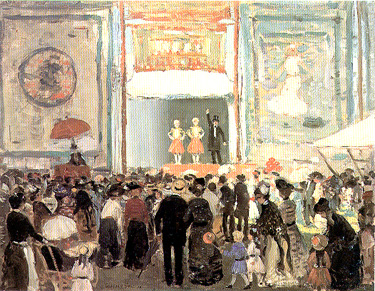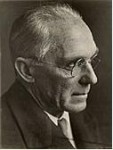
Gifford Reynolds Beal
American, 1879-1956
Sideshow, 1910
oil on canvas
28 1/8 x 36 1/8 in.
SBMA, Gift of Mr. and Mrs. Sterling Morton for the Preston Morton Collection
1959.66

Undated photo of Beal.
RESEARCH PAPER
This painting, aptly called Sideshow, is thought to be the artist’s impression of his visit to Barnum and Bailey’s “Greatest Show on Earth” during its visit to the New York town, Newburgh-on-Hudson, in May, 1910. The scene is the large sideshow arena with the barker pitching the wonders of the show to the assembled circus-goers milling around in front of the tent. The painterly application of color emphasizes the brush strokes and rich areas of heavy impasto creating mounds of paint in high relief on the surface. The basic support is a tightly woven medium weight fabric, which has been covered with a white ground of medium thickness. There are some areas of cracking in the paint and the surface coating, a natural resin, has slightly yellowed. However, the overall condition of the piece is good.
Mr. and Mrs. Sterling Morton donated this piece to the Santa Barbara Museum of Art in 1959. They purchased it from Terry DeLapp of Pasadena, California. Before Mr. DeLapp owned the painting, it belonged to the Grant Galleries in New York.
The artist, Gifford Reynolds Beal, was born in 1879 in New York City. His parents encouraged his artistic talent by starting his art training at the age of twelve with William Merritt Chase. He continued his studies with Mr. Chase throughout his university years, attending Princeton and commuting from New Jersey to New York City on weekends. After graduating from Princeton in 1900, he spent two years studying at the Art Students League in New York. Not long after that, not yet twenty-five years old, he established himself as a professional artist. His works were placed in important shows where he won many awards. His involvement in the art world also included holding the presidency of the Art Students League from 1914 through 1929.
Sideshow is not done in Beal’s usual painting style, which was frequently very realistic and highly finished. Painted in 1910, when he was thirty-one years old, the impressionistic style seems to reflect his training with William Merritt Chase. Mr. Chase had studied in Munich, Germany, and brought to his students the “Munich” style, which emphasized vigorous brushwork, adroit use of color, heavy impasto and uniqueness to every subject. It is also possible to see a reference in this painting to the “Ash Can School” of painters. The New York Realists, or “Ash Can Painters”, were a group of eight artists, headed by Robert Henri (1865-1929), who joined together and espoused painting scenes from around the city of ordinary people and events, enjoying urban life and painting with freedom and spontaneity.
Looking at Sideshow, the viewer feels like part of the crowd of circus goers; couples, families, children with balloons, and a nanny with a buggy, forming a mass of people across the bottom third of the painting. The upper two-thirds of the picture is divided into three vertical sections. The bottom half of the center third is the stage where the “talker”, or barker, in top hat, raises his hand to emphasize the amazing sights to be seen in the sideshow. Next to him are two colorfully costumed figures. The outer thirds give the impression of giant circus scenes done in an unclear manner. Beal, being a circus enthusiast has captured in paint the atmosphere of excitement and fun that was the circus, a circus presented during its glory years. Our eye is drawn to the center of the canvas, where the three figures stand out against a muted background, emphasized by the action of the vertical lines formed by the figures in the foreground and the geometric shapes on either side and above. This composition compels us to focus on the barker giving his “pitch”, and to be drawn into the opening of the tent, ready to discover the delights of Beal’s Sideshow.
Beal concentrated his work on portraying the joyful aspects of life. He painted this work before World War I, and could be called a romantic realist. It was a time of major flux in the art world. Along with the American artists of that time, Robert Henri, John Sloan, George Luks, William Glackens, George Bellows, Alfred Maurer, and Walt Kuhn, that era also had, in Europe, the artists Marcel Duchamps, Wassily Kandinsky, Odilon Redon, Henri Matisse, Pablo Picasso, and Georges Braque. It was only three years before the 1913 Armory Show startled New York. Interestingly, Gifford Beal had two paintings catalogued for the Armory Show, but they were not received: Here Come the Elephants and When the Circus Starts.
Prepared for the Santa Barbara Museum of Art Docent Council by Nancy Turnier. March, 1995.
Website preparer: Judy Seborg. February 8, 2004.
Bibliography:
Art in America Editors, “The Artist in America”, W.W.Norton & Company, Inc., ----.
Brown, Milton Wolf. The Story of the Armory Show, Abbeville Press, New York, 1988.
Cheney, Sheldon. The Story of Modern Art, The Viking Press, New York, 1958.
Mendelowitz, Daniel M. A History of American Art, Holt, Rinehart and Winston, Inc., New York, 1970.
The Preston Morton Collection of American Art, Exhibition catalog, Santa Barbara Museum of Art, 1981.
